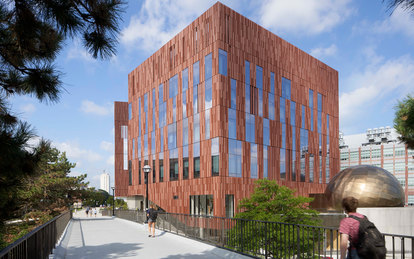University of Michigan Biological Sciences Building Honored with Lab Design Excellence in Innovation Award

Lab Manager recently recognized the University of Michigan Biological Sciences Building (BSB) & Museum of Natural History in its Lab Design Excellence Awards program. The project was honored with an Award for Excellence in Innovation. The 312,000-sf facility is a unique merger of cutting-edge scientific research and the new home of the U-M Museum of Natural History, and has helped establish a new era of science education for a university that is widely recognized as a leading research institution.
Lab Manager’s Lab Design Excellence Awards honor excellence in laboratory design, planning and construction. The Lab Design Excellence Award winners must be cutting-edge facilities that can serve as models for lab design. Each entry is analyzed for its approach to lab design, with a focus on the categories of Innovation, Sustainability and Safety.
The facility’s layout and design are a dramatic departure from traditional rectilinear academic research environments that are siloed by department and closed off from the public. BSB encourages collaboration and puts science on display in fresh new ways.
The form of the BSB creates public views deep into the facility. The five-story structure is comprised of three terracotta and glass-clad towers connected by two large and transparent atria that bring light deep into the laboratories and public spaces. These atria act as vitrines for large-scale exhibits, curated by the museum, which can be seen at a distance, alongside of the research on the upper floors. Recalling a ‘cabinet of curiosities,’ the building form serves to showcase the institution’s mission to educate the public through these monumental views into the collections and research environment.
Designed to accommodate 90 principal investigators and their teams, the BSB includes 84 wet and dry research labs, classrooms, administrative offices, breakout spaces, and Darwin’s cafe. The first floor also houses a team-based, active learning classroom that allows students and professors to reconfigure the space to support a variety of hands-on learning objectives. The space is equipped with three interactive projectors and dozens of monitors to support collaborative group projects and give students the opportunity to showcase current projects.
The merging of the BSB with the university’s Museum of Natural History – which is configured as a series of public galleries and exhibits that allow visitors to wind their way through the first and second floors of the BSB – gives the community access to longtime favorite exhibits, such as a pair of mastodon skeletons. New museum amenities include a 60-seat, state-of-the-art planetarium and domed theater; a multimedia science forum which will bring visitors face-to-face with scientists and researchers, investigate labs for hands-on learning, and many interactive exhibits. On the main floor, a glass-enclosed Fossil Prep Lab – one of two Science at Work exhibits -- demonstrates the university’s commitment to sharing research activities with the public. The interactive space enables visitors to watch scientists prepare fossils for study and display. Guests are also invited to utilize a two-way intercom system to engage with researchers and ask questions about the work that is underway. Visitors can also enjoy a similar experience at the Biodiversity Lab, located on the second floor of the BSB.
The winning project teams will be honored during the Lab Design Digital Summit, May 11-13, 2021.
The Detroit office of SmithGroup (Architect of Record) and New York, New York-based Ennead Architects (Design Architect) worked in partnership to bring the project to fruition. Southfield-based Barton Malow served as the contractor. Museum exhibits were designed by Great Plains Exhibit Development Joint Venture led by Lord Cultural Resources, Xibitz and Taylor Studios.
For more information about SmithGroup, please visit our Company Fact Sheet.